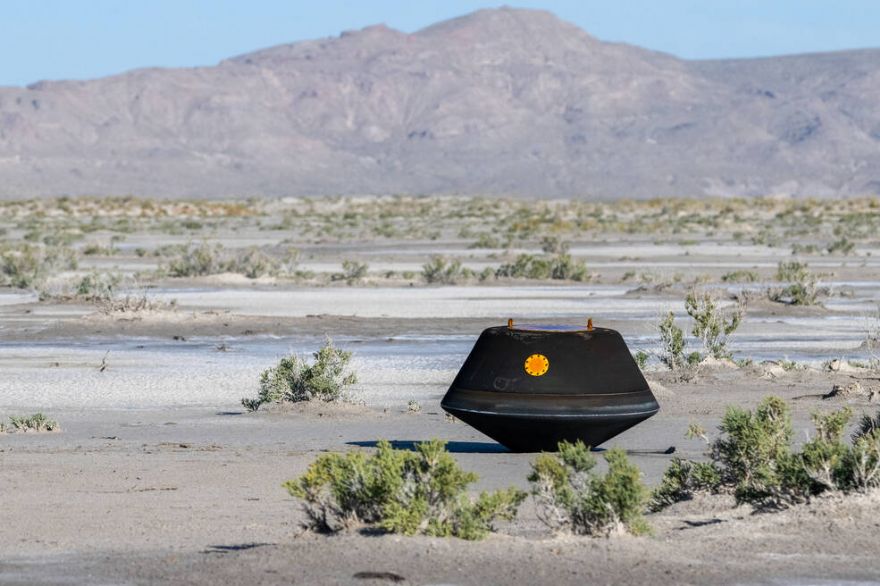
After years of anticipation and hard work by
NASA’s OSIRIS-REx (Origins, Spectral Interpretation, Resource Identification and Security – Regolith Explorer) team, a capsule of rocks and dust collected from asteroid Bennu safely returned to Earth on Sunday (24 September). It landed in a targeted area of the Department of Defense’s Utah Test and Training Range near Salt Lake City and within 1.5hr, the capsule was transported by helicopter to a temporary clean room set up in a hangar on the training range, where it now is connected to a continuous flow of nitrogen.
Getting the sample under a “nitrogen purge,” as scientists call it, was one of the OSIRIS-REx team’s most critical tasks initial tasks. Nitrogen is a gas that doesn’t interact with most other chemicals, and a continuous flow of it into the sample container inside the capsule will keep out earthly contaminants to leave the sample pure for scientific analyses.
The returned samples collected from Bennu will help scientists worldwide make discoveries to better understand planet formation and the origin of organics and water that led to life on Earth, as well as benefit all of humanity by learning more about potentially hazardous asteroids.
NASA administrator Bill Nelson said: “Congratulations to the OSIRIS-REx team on a picture-perfect mission – the first American asteroid sample return in history – which will deepen our understanding of the origin of our solar system and its formation. Not to mention, Bennu is a potentially hazardous asteroid, and what we learn from the sample will help us better understand the types of asteroids that could come our way.
“With OSIRIS-REx, Psyche launch in a couple of weeks, DART’s one-year anniversary, and Lucy’s first asteroid approach in November, ‘Asteroid Autumn’ is in full swing. These missions prove once again that NASA does big things. Things that inspire us and unite us. Things that show nothing is beyond our reach when we work together.”
The Bennu sample – an estimated 250 grams – was transported in its unopened canister by aircraft to NASA’s Johnson Space Center in Houston yesterday. Curation scientists there will now disassemble the canister, extract and weigh the sample, create an inventory of the rocks and dust, and, over time, distribute pieces of Bennu to scientists worldwide.
The delivery of an asteroid sample – a first for the USA – went according to plan thanks to the massive effort of hundreds of people who remotely directed the spacecraft’s journey since it launched on 8 September, 2016. The team then guided it to arrive at Bennu on 3 December 2018, through the search for a safe sample-collection site between 2019 and 2020, sample collection on 20 October 2020, and during the return trip home starting on 10 May 2021.
Dante Lauretta, principal investigator for OSIRIS-REx at the University of Arizona in Tucson, said: “This marks an extraordinary milestone not just for the OSIRIS-REx team but for science as a whole. Successfully delivering samples from Bennu to Earth is a triumph of collaborative ingenuity and a testament to what we can accomplish when we unite with a common purpose. But let us not forget – while this may feel like the end of an incredible chapter, it is truly just the beginning of another. We now have the unprecedented opportunity to analyse these samples and delve deeper into the secrets of our solar system.”
After traveling billions of miles to Bennu and back, the OSIRIS-REx spacecraft released its sample capsule toward Earth’s atmosphere on Sunday morning. The spacecraft was 63,000 miles from Earth’s surface at the time – about a third of the distance from Earth to the Moon.
Travelling at 27,650mph, the capsule pierced the atmosphere, off the coast of California at an altitude of about 83 miles. Within 10min, it landed on the military range. Along the way, two parachutes successfully deployed to stabilise and slow the capsule down to a gentle 11mph at touchdown.
Rich Burns, project manager for OSIRIS-REx at NASA’s Goddard Space Flight Center in Greenbelt, Maryland, said: “The whole team had butterflies, but that is the focused anticipation of a critical event by a well-prepared team.”
Radar, infrared, and optical instruments in the air and on the ground tracked the capsule to its landing coordinates inside a 36 x 8.5-mile area on the range. Within 7min, the recovery team was dispatched to the capsule’s location to inspect and retrieve it. The team found the capsule in good shape and then determined it was safe to approach. Within 70min, they wrapped it up for safe transport to a temporary clean room on the range.